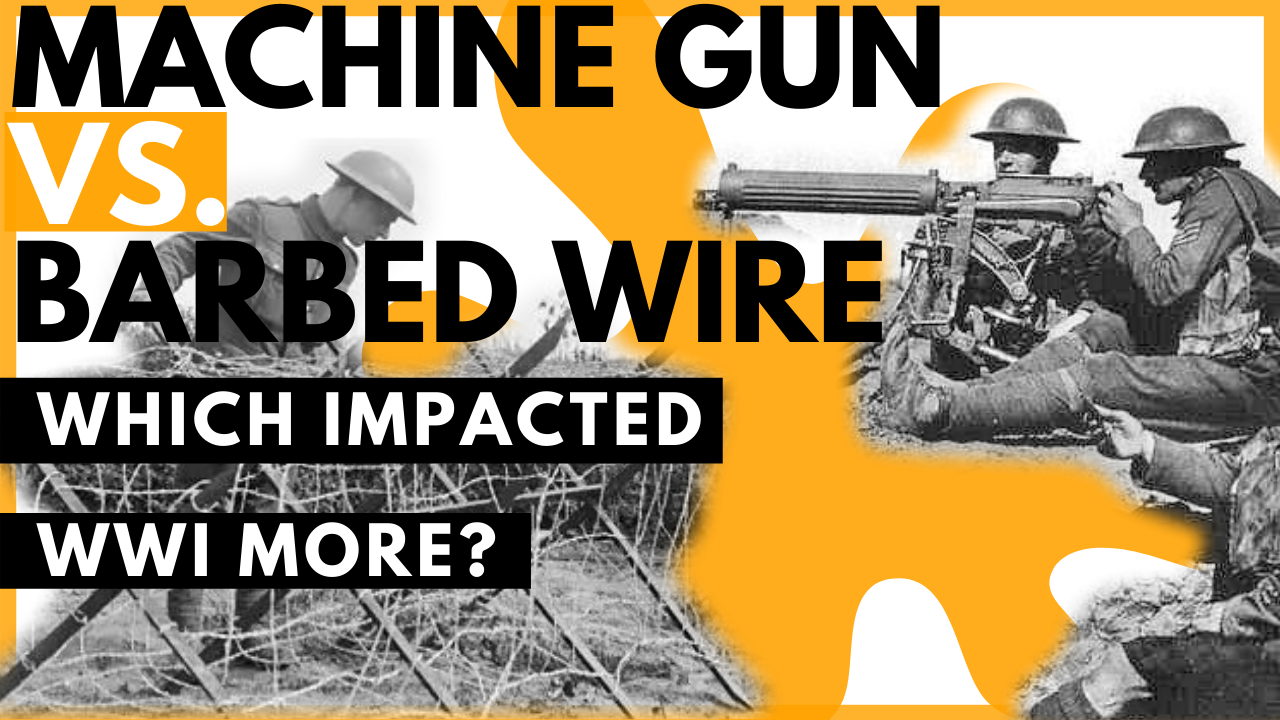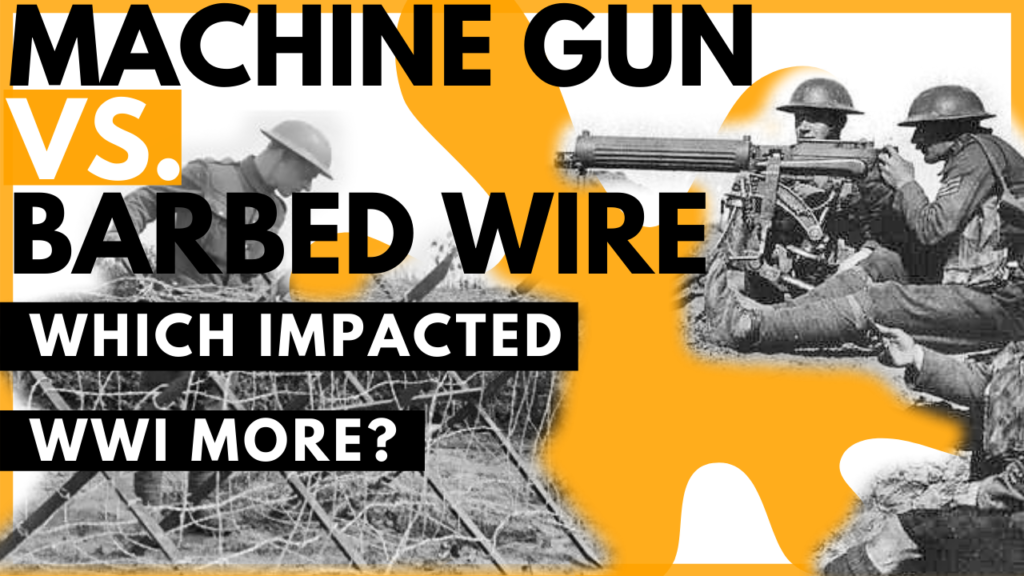Watch the video on YouTube by clicking here or on the image.
World War One was the perfect storm of political pride, entangled alliances, and the introduction of new technology to create the bloodiest war the world had ever seen up to that point.
And because it was the first war to really see the full scale mobilization of industry to bring mass production and use of new technologies, that got me thinking — what widely used technology had more impact during World War One: The Machine Gun or Barbed Wire?
So, that’s what we’re going to argue about today on Argue About It!
The Big Three
In Argue About It Fashion, we’re going to start with an overview of the war, then compare each technology based on “THE BIG THREE”
For today’s argument, the Big Three are: (1) Which had the greater impact on MILITARY STRATEGY? (2) Which DIRECTLY led to more casualties? (3) Which INDIRECTLY Led to more casualties
But first, an overview:
OVERVIEW OF WORLD WAR ONE
In your high school history class I’m sure you chatted a little bit about World War One — Trenches, No Man’s Land, Artillery, and all the other military and economic inventions of the period.
But to weigh in on this argument between the Machine Gun and Barbed Wire, we first have to understand when this conflict took place.
It started in 1914 when, as is famously said, the “Shot heard around the world” was fired by Serbian Nationalist Gavrilo Princept killing heir to the Austria-Hungary throne Arch Duke Franz Ferdinand and his wife Sophie.
Significant to our argument is that this assassination took place in a world that had gone through the Industrial Revolution.
Mass Production and economies of scale had ushered in a different kind of warfare — what we would call modern warfare. Guns, Vehicles, Airplanes, standardized rations — they were all produced in factories and on assembly lines at a rate the world had never seen before.
And as the war churned on, the casualties were unlike anything the world had ever seen before too.
19 million dead, 23 million wounded, 42 million total casualties — for perspective the United States Civil War had only 600,000. The Franco-Prussian War had around 32,000 casualties.
So, I mean it’d be like fighting 70 U.S. Civil Wars or 1,300 Franco-Prussian Wars.
And the new technology played a huge role on not only the casualty numbers, but also on the way modern wars would be fought.
And with that, let’s look at the first of the Big Three: Which had a greater impact on Military Strategy?
FIRST: GREATER IMPACT ON MILITARY STRATEGY
So, which had a greater impact on military strategy?
Well, first of all, Let’s look at the Machine Gun.
—> The first modern machine gun was developed by Hiram Maxim in 1885, called the Maxim Machine Gun, and it dramatically changed the way wars were fought. With a firing rate of 500 rounds per minute, the Maxim machine gun could equip a group of soldiers with maximum amount of fire power for a minimal amount of troops — usually a group of 4 soldiers were assigned to the machine guns.
But the thing was HEAVY! Weighing in at 136 pounds with the base and gun altogether — and this did not including belts of ammunition.
To demonstrate just how reliant the military strategy was on the Machine Gun, in 1914, 12,000 machine guns existed in the German army. By 1918, that number grew to 100,000! In 4 years, the German army had deployed over 88,000 more machine guns in their army!
And since more units had them, more units used them! German commanders reported that 90% of all small arms ammunition that they used was machine gun ammo.
On the French side of things, it can be said that the entire French Plan for the War (French Plan 17) had to be scrapped because the machine-gun caused such heavy casualties to the repeatedly attempting to advance French forces.
HOWEVER, and hear me out on this one, as much of an impact that machine guns had on military strategy, it was BARBED WIRE that created the killing fields on the Western Front of the war.
Barbed wire was used EVERYWHERE because it was cheap, light weight, and served as a mobile IMPENETRABLE barrier. It could be deployed in no mans land, funneling opposing troops into killing zones that decimated the ranks.
It could be said that barbed wire, because it was so heavily relied on by each army, was what was responsible for a prolonged war. In fact, over 1,000,000 miles of barbed wire were used on the Western Front alone — that’s enough to circle the earth 40 times!
Yes, Machine Guns were relied upon by each army for strategic purposes, but it was Barbed Wire that was deployed with greater levels of strategic advantage and caused the war to unfold the way it did.
Second: Which led DIRECTLY to more casualties?
Next let’s look at which technology DIRECTLY caused more casualties.
The Maxim Machine Gun’s killing power was devastating.
For example, in the 1893 Matabele War, a group of 50 British Soldiers were able to hold off 5,000 Matabele warriors with just 4 Maxim Machine Guns.
In Belgium, in the early days of the war where they (surprisingly enough) used dogs to haul machine guns, the Maxim Machine gun killed so many troops, and the bodies piled up so quickly, that they didn’t know whether to keep firing through the piles of bodies or wait to fire once the enemy advanced beyond the bodies — it was really a problem for them!
And, in large part due to the machine gun, after just one month of fighting, the casualties were unlike anything anyone had ever seen from a war throughout the course of human history. 300,000 Germans, 300,000 French, and 30,000 British were casualties of war!
The Battle at the Nek is another example of how devastating the Machine Gun was at inflicting enemy casualties: When at that battle the New Zealand and Australian forces ran out into No Man’s Land to overtake Turkish positions, the Turks mowed them down, inflicting over 50% casualties and not budging an inch. Leutenant Colonel Noel Brazier said, “The whole thing was nothing but bloody murder.”
Barbed wire did directly lead to casualties though.
Because it was deployed in layer upon layer, zig-zagging across No Man’s Land, it could act as a sort of spider web and cut and catch troops trying to move through it. One soldier recalls, “Colonel pope, the commanding officer of the Borderers, becomes a casualty. Tripping over some rusty wire he falls and punctures his face. Two years later a military funeral leaves Alillbank Hospital and on the gun carriage are the mortal remains of Pope. The Dirty Wire Killed Him.”
But even though barbed wire did directly kill some of the unfortunate troops who became cut or entangled it its barbs, the extreme amount of lead hurled through the air by the machine gun ultimately directly led to more casualties than did the wire.
Third: Which led INDIRECTLY to more casualties?
The last category for our argument is which INDIRECTLY led to more casualties?
One of the most fun and interesting lenses to look at World War One through is that of iteration. Throughout the war different technologies and uses for technology are constantly built upon and improved on each other.
The machine gun, for example, would be mounted on tanks and airplanes — which made those vehicles all the more deadly even though they saw only limited action in World War One.
BUT it was barbed wire that made EVERY SINGLE weapon more deadly by slowing down the speed at which troops could move, and directing them into killing zones.
It was the need to overcome a stagnant Western Front due to barbed wire that led to the development of the tank, to the use of airplanes as artillery spotting machines, even to Chemical Warfare which could waft through the wire into enemy trenches. And don’t forget about the wide-spread use of constant artillery bombardments to try to soften up the enemy so that once troops could overcome the barbed wire, they would be able to take the opposing trench.
So while the machine gun was adapted to fit various machinery, it was really barbed wire that kept armies pinned down long enough or slow enough so that the machine gun, rifle, or artillery fire could wipe them out.
The Winner…
And that’s why Barbed wire wins this argument for having the greatest impact on World War One. Sure, it didn’t directly kill as many people as the machine gun did, but it DID create the circumstances, the environment that led to the nearly 42,000,000 casualties in World War One.
Agree? Disagree? Let’s continue the argument below with your thoughts!


